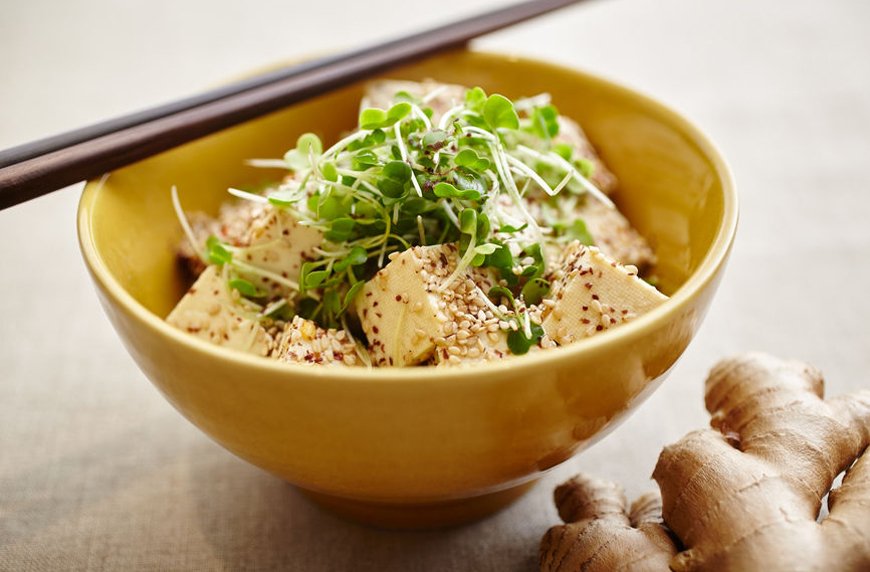The difference between tempeh and tofu.
We called it: 2019 is the year of the alt-meat. But while food innovation has gifted plant-based, vegan, and vegetarian eaters with an array of meat-like options (looking at you, “bleeding” burger patty), the OG sources of vegan protein—tempeh and tofu—have proven that they aren’t going anywhere. But in the battle of tempeh vs protein, who reigns supreme?
First things first: It’s abundantly clear that both protein sources have earned their staying power. Not only do they happen to taste delicious tossed on top of a salad/rice bowl/taco/literally anything, they’ve also got the health benefits to back up their good flavor. But while both meatless options are essentially super-versatile soy, there are key differences in texture, taste, and health benefits. Plus, according to an RD, tofu is the best alt-meat out there for plant-based beginners, while tempeh is the best for your gut. (TL,DR: Just because there are newer, shinier options out there, don’t count out everyone’s old favorites.)
Considering even meat-eaters could benefit from regularly eating plant-based meals (#MeatlessMonday, anyone?!), I asked plant-based specialist Lori Zanini, RD, CDE and author of the Diabetes Cookbook and Meal Plan for the Newly Diagnosed and Reema Kanda, RDN, at Hoag Orthopedic Institute, Irvine CA to break down health differences between the two vegan proteins that get the most love.
Below, Zanini and Kanda explain these two meatless faves and then answer which ultimately wins out in the plant-based protein battle of tempeh vs. tofu.
What is tempeh, exactly?
Tempeh is made from fermented soybeans that have been soaked, hulled, cooked, and then molded into a patty-like shape. Of course, there’s some variation in the shape the cooked soy beans get molded into, like tempeh sold in bacon-like strips.
While fermented soybeans are the main ingredient, tempeh often contains any or all of the following: quinoa, barley millet, flax seed, brown rice, sesame seeds and spices. This means sometimes tempeh is gluten-free, but other times it is notHave you ever been cheated on during the holiday season?; it ultimately comes down to the manufacturer. Most tempeh products wily either “gluten-free” or “contains wheat” on the package, so if you’re Celiac make sure to do your label-reading before adding it to your grocery cart.
The taste of tempeh is often described as “earthy,” “hearty,” or “nutty,” and when cooked, it’s a bit chewy. Tempeh is a little like mushroom lattes— you either love it or hate it.

And what’s tofu?
“While both tofu and tempeh are high quality sources of plant-based protein and would make a great post-workout meal, they couldn’t be more different in their production process,” says Kanda. Tofu is also a soybean product, but while tempeh is made directly from cooking and fermenting soybeans, tofu is made from condensed, unfermented soy milk that’s been processed into solid white blocks.
It can be a little hard to visualize, so think about it this way: You know the pulp that’s left over when you make almond milk? Tofu is essentially made by combining this “pulp” with a thickening coagulant (and water). That’s why tofu is sometimes considered more processed than tempeh.
You can get tofu in a variety of textures such as “silky,” “firm,” and “soft,” but it usually has a Jell-O-like jiggle. And while tofu can be sold spiced, it’s generally flavorless. “Because tempeh has a heartier taste, some people prefer to use it as meat substitute. Tofu on the other hand has a more neutral flavor and absorbs the taste of the other ingredients or spices it’s combined with. It can be used in smoothies, stir-fries, soups…,” says Kanda, adding that it’s a good replacement for eggs in many dishes.
Tofu vs. tempeh: Which is healthier?
“Nutritionally, tofu and tempeh carry very similar nutrient profiles, and either would make a beneficial addition to a healthy breakfast or meal,” Zanini says, but she adds that they do have differences. Nutritionally, here’s how it all breaks down based on one serving (aka 100 grams) of each protein.
Tofu:
- Protein: 8 grams
- Fat: 5 grams
- Carbohydrates: 2 grams
- Calories: 76
Tempeh:
- Protein: 20 grams
- Fat: 12 grams per 100g of cooked tempeh
- Carbohydrates: 8 grams
- Calories: 195
Generally, tempeh is higher in protein than tofu. “That’s because legumes, grains, nuts, and seeds may be used to make tempeh,” says Kanda—lending to a richer source of protein. If your goal is to incorporate more protein and healthy fats, tempeh may be the way to go.
Tempeh may have more calories and fat content, but Kanda says comparing two 100 gram servings is slightly misleading because 100 grams of tempeh will be more filling than 100 grams of tofu, thanks to its high protein and fiber. You may have to eat more tofu to feel full because one serving is so low in calories, protein, and fat.
Micronutrients
Even in the nitty gritty nutrient-details, there aren’t a ton of differences between the two soy products. “Tofu contains 1 milligram of iron per serving and is a source of alpha-linolenic acid, the essential omega-3 fatty acid. Some brands of tofu are fortified with vitamin B12 and vitamin D, and extra calcium—of which there’s naturally a lot,” says Kanda.
Tempeh on the other hand, contains about 10 percent of your daily iron and calcium needs. Because tempeh is fermented, it can help your gut health and will keep you regular. Both tofu and tempeh contain magnesium, potassium, sodium and zinc.
Other factors, tastes, and uses
Aside from the nutritional information, there’s the whole question about whether or not soy is actually safe to eat. While some wellness practitioners advise their patients not to eat soy due to its “estrogen-like effects” in the body, the American Cancer Society says that consuming moderate amounts of soy foods is safe for everyone. Kanda follows the ACS guideline, and encourages her patients to eat soy in moderation and not every day.
Of course, since both tofu and tempeh can be part of a healthy diet, a lot of the decision comes down to what you’re craving and how you cook them. “Either option would be a great meat-substitute in any meal,” says Zanini. But when your shopping for tempeh aim for one that is as simple as possible. Flavored tempeh often has a lot of added sugar and salt. And of course, if you’re gluten-free check the label.
While tempeh has a heartier taste that makes it optimal as a meat-replacement, tofu is essentially flavorless which means it has more culinary uses. “Either way,” says Kanda, “both offer a great complete protein option for plant-eaters.”
Gabrielle Kassel, October 18, 2018

 NO
NO nope
nope no
no